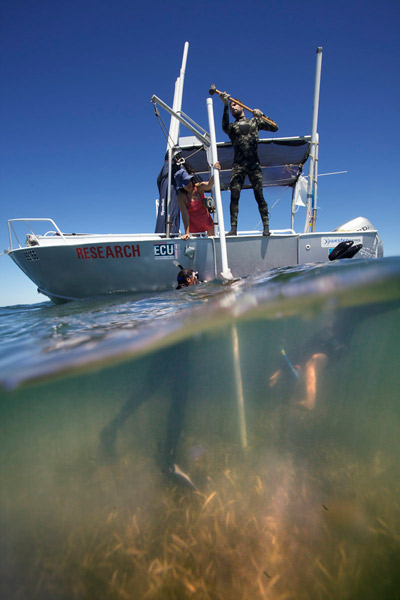The Missing Kingdom: Why Fungi Must Be Central to Conservation Strategy
28 December 2025
Published online 22 March 2018
Shark Bay seagrass meadows have released millions of tonnes of carbon dioxide when devastated by marine heatwaves, new study reveals.

© Joan Costa
Now, a new study in Nature Climate Change reports that 36% of the seagrass meadows located in Shark Bay—a UNESCO World’s Heritage site on the Australian West coast—were damaged, releasing a large quantity of carbon dioxide that had been previously sequestered by underwater plants for 4,000 years.
Besides myriad ecological benefits, such as sediment stabilization, coastal protection, providing shelter and food to marine animals, seagrasses store extraordinary amounts of carbon dioxide in their biomass and in their below-ground root system.
“One hectare of seagrass in Shark Bay stores the same amount of carbon as five hectares of tropical forest,” says Carlos Duarte, study co-author and professor of marine ecology at King Abdullah University of Science and Technology's Red Sea Research Center.
Shark Bay seagrasses, which cover 4,300-kilometer square, can store up to 1.3% of the world’s total carbon accumulated in the top meter of seagrass sediments. In their paper, the scientists now estimate that if 10-50% of the seagrass sediment carbon stock was exposed to oxygen during the 2010-2011 heatwave, two to nine million metric tonnes of CO2 could have been released in the atmosphere in the following three years.
Ariane Arias-Ortiz, marine and environmental PhD student at Barcelona’s Universitat Autònoma and the study’s lead author, explains that when you lose the seagrass canopy which stabilizes the sediments below, tidal currents disrupt the carbon stored in the soil which is rapidly decomposed by microbes.
“This is when this ecosystem shifts from being a carbon sink to a source of CO2 emissions,” she says.
Seagrass meadows worldwide offset between 0.6 to 2% of global anthropogenic CO2 emissions. Since the beginning of the 20th century, coastal development, reckless anchoring and water quality degradation have reduced seagrass coverage by 0.9% annually.
“Heatwaves are predicted to increase in frequency in the future, and will threaten seagrass meadows,” says Ankje Frouws who researches seagrass resilience at Edith Cowan University in Perth, Australia. “Although [this] study focuses on Shark Bay, the results apply to seagrass species at the boundary of their thermal range everywhere.”
Safeguarding this crucial ecosystem primarily depends on drastic cuts in global emissions, but local conservation can also provide temporary relief for seagrass by minimizing local threats such as eutrophication, pollution and anchoring, according to Arias-Ortiz.
“Recovery of damaged sites requires the presence of healthy seagrass patches nearby, because rhizomes, which are part of the root system of seagrasses, extend horizontally,” says Frouws, who points out that this becomes more problematic when the damaged area is extensive.
By studying seagrasses’ genotypes, scientists can also determine which species are capable of withstanding thermal stressors, and genotypic mapping could pinpoint the locations that needs to be prioritized in conservation.
doi:10.1038/nmiddleeast.2018.31
Stay connected: